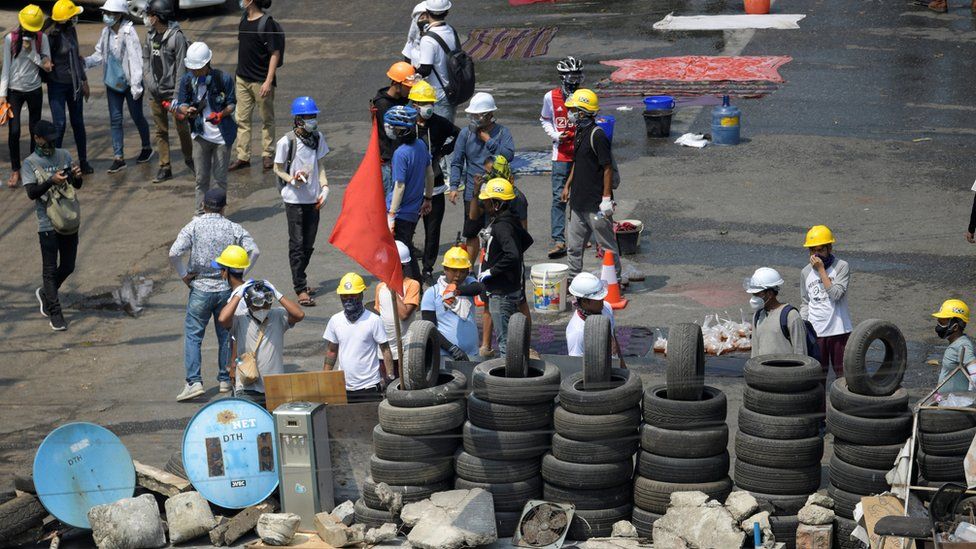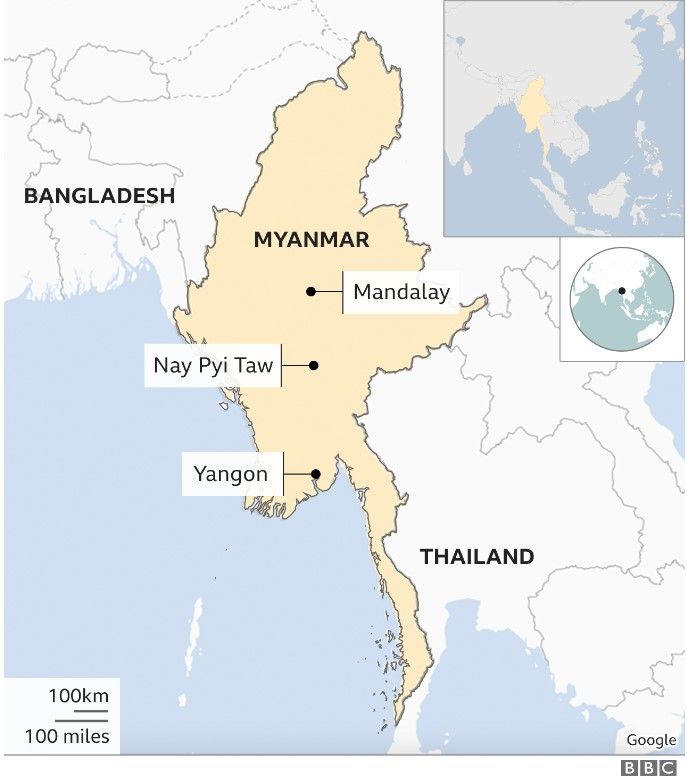Video footage shows anti-coup protesters running to avoid police tear gas
At least 38 people were killed in Myanmar on Wednesday, the UN confirmed, marking the worst day of violence since protests against military rule began.
Security forces opened fire on large crowds in a number of cities and at least two of the victims are believed to be teenage children.
Mass demonstrations have been taking place across Myanmar since the military seized control on 1 February.
It comes a day after Myanmar's neighbours called for restraint.
Christine Schraner Burgener, the UN's envoy to Myanmar described Wednesday as the "bloodiest day" since the coup took place on 1 February. She said that more than 50 people have died since then.
The coup saw elected government leaders, including Aung San Suu Kyi, overthrown and detained. Protesters are calling for their release and an end to military rule.
The general who returned Myanmar to military rule
At least 38 people were killed in Myanmar on Wednesday, the UN confirmed, marking the worst day of violence since protests against military rule began.
Security forces opened fire on large crowds in a number of cities and at least two of the victims are believed to be teenage children.
Mass demonstrations have been taking place across Myanmar since the military seized control on 1 February.
It comes a day after Myanmar's neighbours called for restraint.
Christine Schraner Burgener, the UN's envoy to Myanmar described Wednesday as the "bloodiest day" since the coup took place on 1 February. She said that more than 50 people have died since then.
The coup saw elected government leaders, including Aung San Suu Kyi, overthrown and detained. Protesters are calling for their release and an end to military rule.
The general who returned Myanmar to military rule
Aung San Suu Kyi: Democracy icon who fell from grace
The military says it seized power because of alleged fraud in November's general elections, which saw Ms Suu Kyi's National League for Democracy (NLD) party win a landslide victory.
But the military has provided no proof of these allegations - instead, it replaced the Election Commission and promised fresh polls in a year.
What's the latest?
Despite growing international condemnation, the military has escalated its response to the street protests and Wednesday saw violent clashes in a number of areas.
The security forces opened fire in several towns and cities with little warning, witnesses told the Reuters news agency.
At least four people were shot dead during a protest in Monywa in central Myanmar. At least 30 others were wounded in the unrest, a local journalist told Reuters.
Further deaths were reported in Yangon, Mandalay and Myingyan. Some 19 people were injured following one protest on the outskirts of Yangon, AFP agency reported.

Protesters have built barricades in several cities around the country
A volunteer medic told AFP news agency in Myingyan that at least 10 people had been injured there. "They fired tear gas, rubber bullets, and live rounds," they said,
"They didn't spray us with water cannon, [there was] no warning to disperse, they just fired their guns," one protester in the city told Reuters.
In Mandalay, a student protester told the BBC that demonstrators were killed near her house.
"I think around 10am or 10.30, police and soldiers came to that area and then they started to shoot at civilians. They didn't give any warning to the civilians.
"They just came out and they started to shoot. They used rubber bullets but they also used live bullets to kill civilians in a violent way."
The military has not commented on the reported deaths.
The latest round of violence follows a meeting between foreign ministers of neighbouring South East Asian nations. The group urged restraint, but only some of the ministers pressed the military junta to release Ms Suu Kyi.
Ms Suu Kyi, 75, was seen for the first time since her detention earlier this week when she appeared in court via video link. It followed the deadliest day of violence yet on Sunday when 18 people were killed.
A volunteer medic told AFP news agency in Myingyan that at least 10 people had been injured there. "They fired tear gas, rubber bullets, and live rounds," they said,
"They didn't spray us with water cannon, [there was] no warning to disperse, they just fired their guns," one protester in the city told Reuters.
In Mandalay, a student protester told the BBC that demonstrators were killed near her house.
"I think around 10am or 10.30, police and soldiers came to that area and then they started to shoot at civilians. They didn't give any warning to the civilians.
"They just came out and they started to shoot. They used rubber bullets but they also used live bullets to kill civilians in a violent way."
The military has not commented on the reported deaths.
The latest round of violence follows a meeting between foreign ministers of neighbouring South East Asian nations. The group urged restraint, but only some of the ministers pressed the military junta to release Ms Suu Kyi.
Ms Suu Kyi, 75, was seen for the first time since her detention earlier this week when she appeared in court via video link. It followed the deadliest day of violence yet on Sunday when 18 people were killed.
What's the background to this?
Myanmar's military seized power after overthrowing the government and declared a state of emergency.
Just days later, the civil disobedience movement began to emerge - professionals who are refusing to return to work in protest.
Myanmar coup: What is happening and why?
The movement quickly started to gain momentum and it was not long before hundreds of thousands of people began taking part in street protests.
But there has been an escalation of violence between police officers and civilians in recent days.
media captionGunfire was heard on the streets as police cracked down on protests

Myanmar in profile
Myanmar, also known as Burma, became independent from Britain in 1948. For much of its modern history it has been under military rule
Restrictions began loosening from 2010 onwards, leading to free elections in 2015 and the installation of a government led by veteran opposition leader Aung San Suu Kyi the following year
In 2017, Myanmar's army responded to attacks on police by Rohingya militants with a deadly crackdown, driving more than half a million Rohingya Muslims across the border into Bangladesh in what the UN later called a "textbook example of ethnic cleansing"


No comments:
Post a Comment